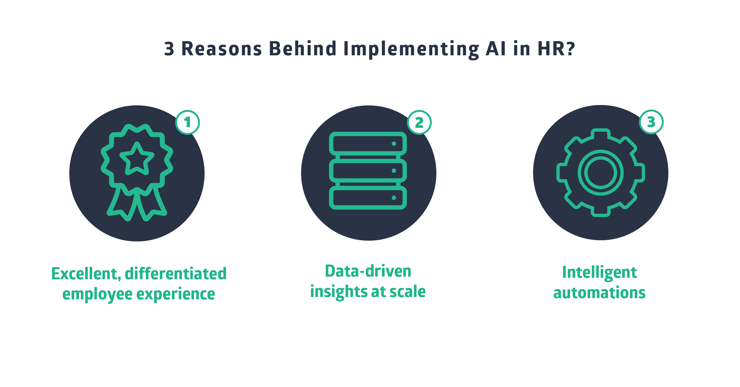The Ultimate Guide to HR Digital Transformation (Part 2)

In the same way that technology improved marketing and sales, it’s now transforming human resources management. HR departments are now using sci-fi tech, and with the help of artificial intelligence, Big Data, and machine learning, HR is reinventing decades-old processes.
What is artificial intelligence?
AI is an intelligent machine capable of thinking like the best human. It executes tasks that, until now, have been squarely in the human domain — learning and adapting, critical thinking, reasoning, problem-solving, and language processing. This leap was made possible by two underlying technologies: machine learning and deep learning.
What is machine learning?
Machine learning is a part of AI that allows algorithms to automatically learn from large datasets. Basically, the algorithm tries to come up with a set of rules or patterns which would allow the program to make predictions or decisions. For best results, human supervision is important because the data needs to be structured properly.
With AI, HR software can be programmed to recognize anomalies (for example, drops in performance or engagement), run background checks on applicants (based on resumes of successful applicants), identify employees that are considering leaving (and suggest re-engagement activities), and more.
What is deep learning?
Deep learning is a more advanced branch of machine learning. Instead of relying on predefined patterns and data points, a DL algorithm makes use of more complex machinery to identify relationships between various inputs. In a sense, it approaches data similarly to how a human would learn and draw conclusions. This makes it one of the most powerful techniques available to interpret complex data and make accurate predictions at scale.
With deep learning, chatbot assistance will continue to improve (as software gets better at recognizing language, context, and tone). This will allow delivery automation of various HR services. Additionally, learning recommendations will become more personalized for individual employees.
3 reasons why you should implement AI in HR

The ‘why’ behind AI in HR is three-fold, and while it’s not a magic bullet that will obliterate all of the challenges that HR departments are faced with today, AI will make those departments more effective in dealing with them.
The three main business reasons for AI in HR are:
- Employee Experience. Compensation, benefits, and career stability are becoming increasingly less important to modern employees. What they want is an excellent, differentiated employee experience. This experience encompasses everything from tailor-made onboarding to on-the-job assistance (for example, a voice-powered virtual assistant that answers work-related questions). AI-driven human resources software makes this possible.
- Data-driven insights at scale. HR departments collect and analyze data automatically. And then, they hit a bottleneck because that data is still interpreted by either data scientists or end-users. This creates delays in decision-making. With AI, those delays become a thing of the past. Thousands of resumes can be scanned, sorted, binned, or advanced within minutes. Performance reviews can be analyzed, with recommendations for each individual employee produced instantly. In addition to expediency, two of the biggest benefits of this approach are unbiased data interpretation and a reduction in human errors.
- Automating the boring bits. But not really because they’re boring… more because they’re a) time-consuming, and b) software does them error-free. With AI, this automation can turn into intelligent automation. This means that even those processes that used to require human intervention can now be automated because the software will reach a valid, data-based decision.
The impact of AI on 5 major areas of HR
Right now, there’s a lot of experimenting with artificial intelligence in human resources management. That’s a nice way of saying that we’re not still 100% certain where we’ll land with it all.
The same thing happened with sales and marketing when they were implementing their digitally forward strategies and AI-driven solutions. A couple of minor setbacks. But things eventually settled and today, sales and marketing are infinitely better thanks to technology.
The same will happen in HR sooner rather than later. In fact, AI-powered HR digital transformation is already impacting five crucial areas of HR, bringing an innovative and data-driven approach to stale, old processes.
- AI in human capital management (HCM). Imagine an HCM solution that can figure out when to promote someone. Or how to create an onboarding roadmap for a specific role, schedule training sessions, and initial meetings, or find the best onboarding buddy?
You don’t need to imagine too hard because we’re already there. Solutions such as Oracle HCM Cloud, Workday HCM, or SAP SuccessFactors already use AI to guide HR managers in making these decisions. And these solutions will only get better the more they’re used and trained. - AI in recruitment. Talent sourcing is one of those labor-intensive HR tasks that is slowly being taken over by AI-powered software. This software screens and categorizes job requirements and then finds specialty recruits with a proven track record of delivering a specific subset of candidates. Other software excels at screening candidates and weeding out those not suited for the job. In the very near future, we’ll also be able to collect video interviews, analyze them with our AI-powered recruitment software, and then bring in only the best candidates for additional testing and conversation.
- AI in benefits administration. AI can be of immense help when it comes to tailoring benefits plans to individual employees. It can take their personal circumstances, pre-existing conditions, and goals into consideration and find the most cost-effective providers (of healthcare and retirement plans, for example). Also, chatbots and AI-driven virtual assistants help answer any questions employees might have about benefits (saving your HR team time responding to dozens of identical emails every week).
- AI in learning and development. With the right AI-powered L&D platform, you have access to deeper analytics. This allows you to figure out which employees to train, for what, and when. Additionally, the whole process goes faster — meaningfully personalized content + augmented learning (VR) helps you re-skill and retrain employees at a fraction of the cost and the time.
- AI in employee engagement. Smarter employee engagement solutions are not reactive — they are proactive. With AI, you get to manage employee sentiment before it reaches a critical phase that affects motivation and performance. Things like intelligent surveys, real-time feedback, and personalized communication allow you to constantly keep your ear to the ground and to figure out the real drivers of engagement in your organization.
Plotting your 6 stages of HR digital transformation
Changing well-entrenched and decades-old HR systems and processes doesn’t happen overnight. There are simply too many balls to juggle for this transformation to occur just because you’ve decided it’s time for it.
But, with a plan, you can make it happen. Ready to move to Part 3? Find it here.